2022 State of Accreditation Report
We are pleased to share insights we have gained from AACSB accreditation visits over the past academic year, providing AACSB members with a collective learning experience.
The continuous improvement experience that is a guiding principle for AACSB should be extended to everyone. This report curates the collective wisdom of our peer review visits, including outcomes, best practices, and future opportunities.
Have feedback? We want to hear from you!
2021–22 Accreditation Outcomes and Insights
Business Accreditation
Business Accreditation as of June 30, 2022
Visit Modality
Virtual accreditation visits dominated in 2021–22 as schools in regions around the world continued to struggle with the pandemic.
Initial Accreditation Visits

Continuous Improvement Review Visits
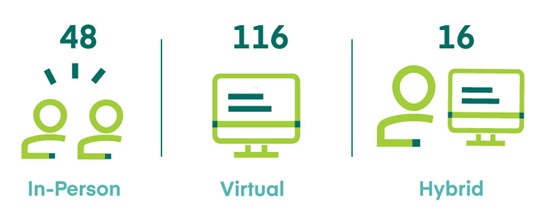
Enrollments
Source: BSQ Programs Module, 2017-18 to 2021-22. Master's enrollment n=500, undergraduate enrollment n=493.The five-year enrollment trend for undergraduates showed a slight rise.


Shifts in Master's Program Enrollment by Discipline
While accounting is still a popular major, other analytical fields, including data analytics and quantitative methods, appear to be attracting learners who might otherwise have majored in accounting.
Finance has seen a 26% increase over the past five years, with more than 7,000 additional learners.

Fastest-Growing Master's Fields, in Percentage Growth, by Discipline
Source: BSQ Programs Module, 2017-18 to 2021-22.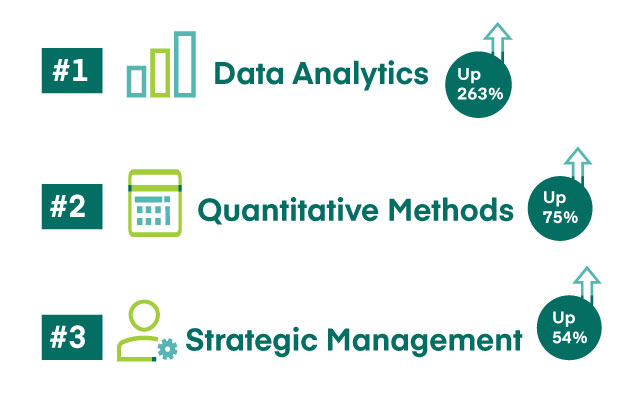
Most Popular Master's Fields of Study, in Headcount
Source: BSQ Programs Module 2021-22.The MBA program remains the most popular graduate degree and continues to grow.
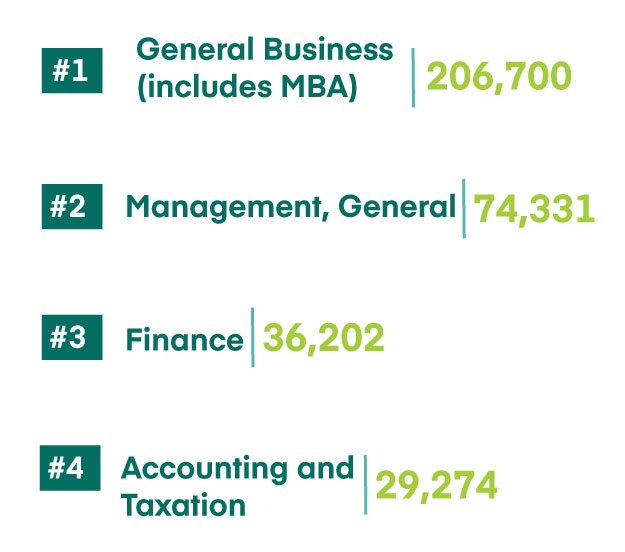
Faculty
Source: Staff Compensation & Demographics Survey (SCDS), 2017-18 to 2021-22, n=617.
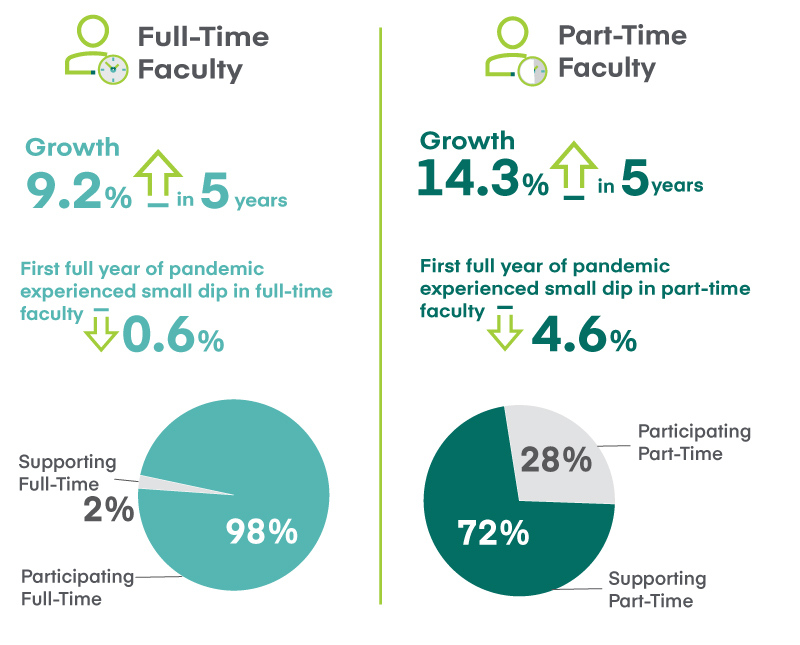
The number of Scholarly Academic (SA) faculty is growing and may be somewhat augmented by the 2020 standards, which have a broader view on what constitutes a terminal degree.
The "additional" category of part-time faculty is high and up by 18%, compared to full-time faculty.
Average Full-Time Faculty Qualifications Ratios for the Past Five Years
Source: Staff Compensation & Demographics Survey (SCDS), 2021-22.
Average Part-Time Faculty Qualifications Ratios for the Past Five Years
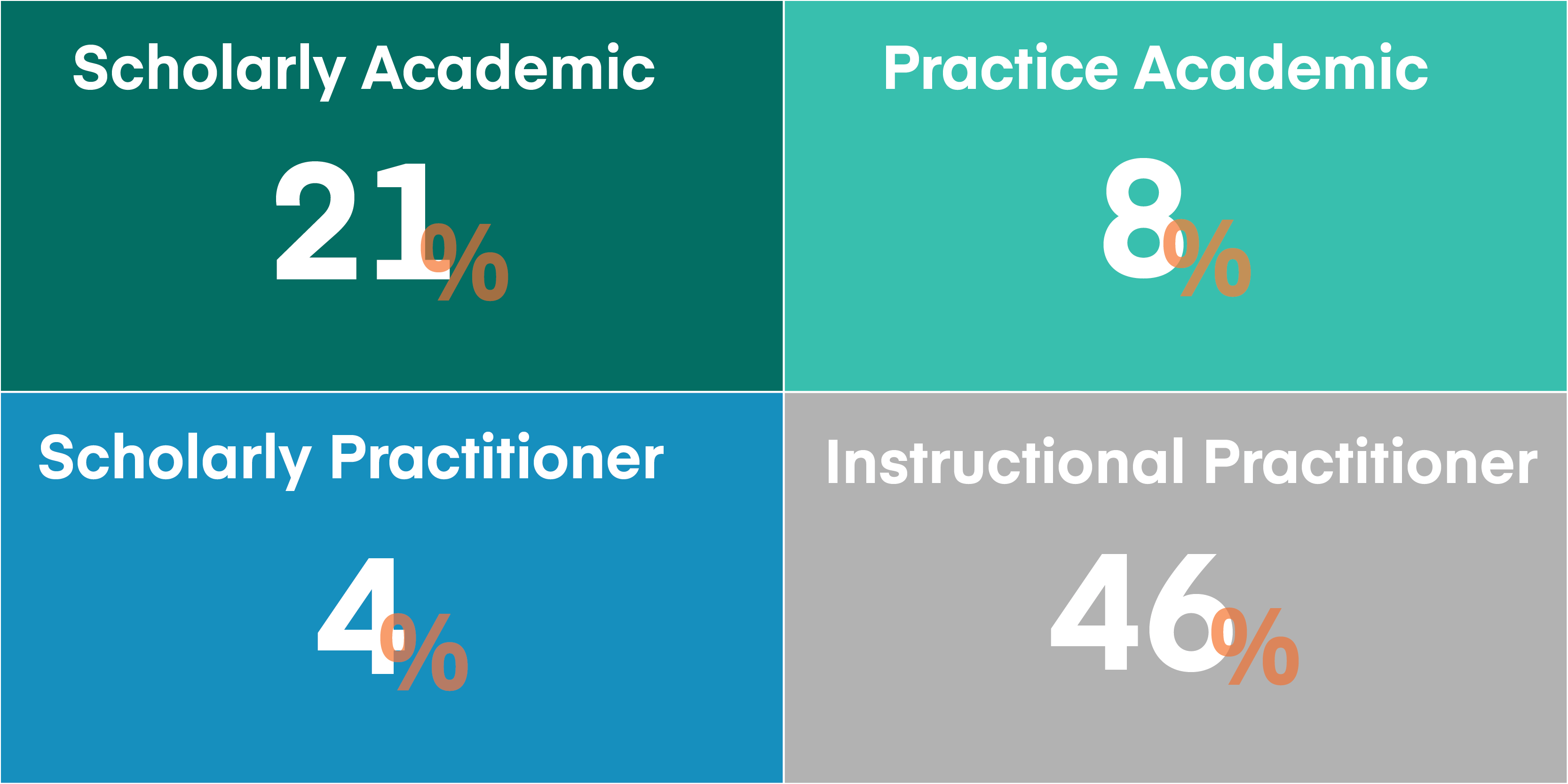
Initial Business Accreditation Outcomes and Insights
The fastest-growing region for accreditation is EMEA.
Number of Schools In Process as of June 30, 2022
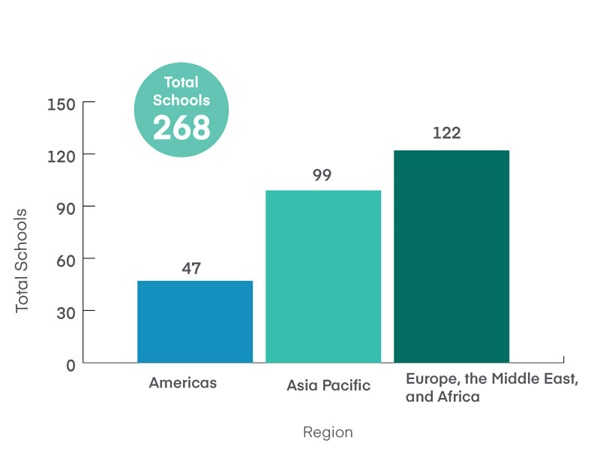
Initial Accreditation Visits Between July 1, 2021–June 30, 2022
Outcomes By Region
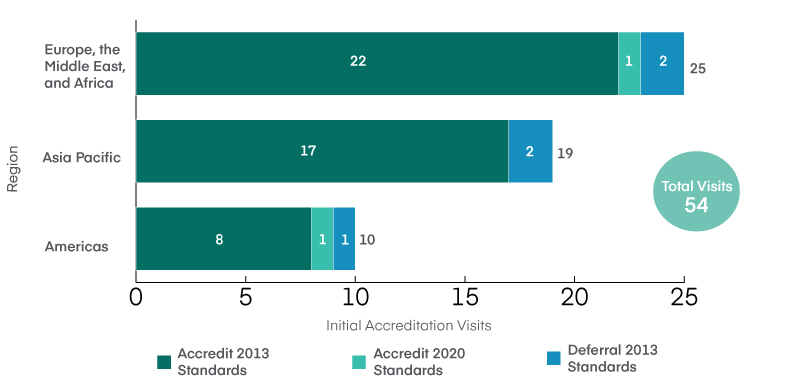
Initial Accreditations Map
Continuous Improvement Review Visit Insights
Continuous Improvement Review Visits Between July 1, 2021–June 30, 2022
Outcomes By Region

Accreditation Extensions Map
2020 Standards Mentioned for Schools with Visits Between July 1, 2021–June 30, 2022 With Extension Recommendations

Standard 1 Common Issues |

- Peer review teams are paying close attention to the school's strategic plan, which is expected to be robust and to guide important decisions on financial resource allocation. Schools are becoming more sophisticated in understanding the value of agile strategic planning, frequently measuring success, and keeping long-term objectives in mind.
- The pandemic negatively impacted enrollment and thus bottom-line budgets for a number of schools. In some cases, schools gave one-time tuition rebates. Schools are hoping to emerge from the negative effects of the pandemic over a period of time.
- Schools are using executive education to make up some of the financial shortfall, though in many schools, executive education also suffered a decline during the pandemic year.
- Peer review teams note that some strategic plans, such as capital improvements and new facilities, were delayed during the pandemic.

- Peer review teams are closely looking at schools’ risk analyses to ensure they are robust and meaningful. Some schools are completing risk analyses involving a wide variety of stakeholders, and not just an administrative exercise. Peer review teams favorably view analyses that present different types of risk and the probability of given risks, which demonstrates good strategic management.

- The strategic plan is expected to be robust with metrics of success and key performance indicators that are clearly stated and measured on a routine basis during the year.
Standard 3 Common Issues |

- Peer review teams are paying close attention to the school’s strategic plan, which guides staffing decisions. Schools are becoming more sophisticated in their strategic planning as they better understand the value of agility in the process while maintaining a long-term view.

- Peer review teams pay a lot of attention to the school’s faculty sufficiency and faculty qualifications criteria (definitions). Even with the principles-based standards, this area of a school's CIR report is one of the most closely viewed by peer review teams.
- Point systems are frequently mentioned as a measure of qualifications, with an eye to not just counting the number of peer review journal articles for SA status.
- The most commonly reported disciplines in Table 3-1 are accounting, business law, economics, entrepreneurship, finance, information systems, management, marketing, operations, and organizational behavior.

- Almost half of the schools reviewed this year noted budgetary restrictions as a stress factor in hiring qualified faculty.

- Schools are focused on ensuring they strategically manage faculty, including in the hiring, retention, and tenure processes. Formal mentoring programs, both teaching and research stipends, travel funds, and sabbaticals are all useful tools to ensure that faculty are adequately supported and set up for success.
Standard 5 Common Issues |

- Peer review teams frequently noted the use of technology across the curriculum, especially related to data analytics, with some schools implementing a required data analytics course in the core curriculum. Other emerging technologies are being implemented across the curriculum, including blockchain, cryptocurrency, fintech, data mining, and data visualization tools. Where needed, departments are restructured to better align disciplines.

- The Assurance of Learning (AoL) process itself was the No.1 topic in school visit reports. PRTs focused on how robust the AoL plan was, including whether schools had "closed the loop" at least once during the five-year look-back period. Small schools find the AoL process particularly challenging, they have fewer resources available to dedicate to this process. PRTs look carefully at whether improvements in curriculum are made as a result of AoL.
- Learning goals should be different for undergraduate versus graduate programs.
- How the school is measuring whether targets are achieved should be meaningful. For example, a target of “satisfactory achievement” is not specific enough to meaningfully assess success.

- Schools are updating their curriculum more efficiently today than they have historically. Particularly with emerging technologies, schools recognize that implementing curriculum change can no longer take years to accomplish.
2020 Standards Mentioned for Visits Between July 1, 2021–June 30, 2022 With CIR2 Recommendations
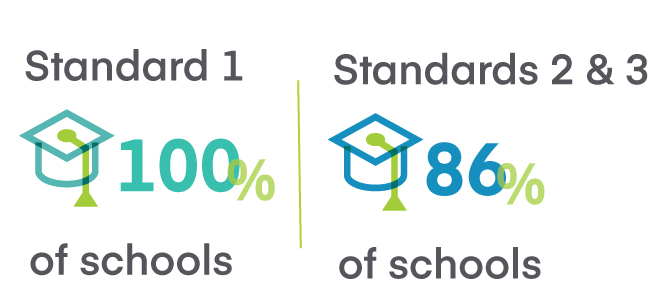
As anticipated under the principles based nature of the 2020 standards, the number of CIR2s shows a downward trend in the first two years of implementation. PRTs are expected to focus holistically on whether the school is aligned with the spirit and intent of the standards vs. a standard-by-standard compliance exercise.
CIR2 recommendations are more likely when a school was asked to address a particular deficiency in the prior accreditation visit and yet the issue remains unresolved.
Schools that receive a CIR2 recommendation typically have numerous material misalignments with the standards as opposed to one single misalignment.
Standard 1 Common Issues |
- The school has incomplete, missing, or outdated strategic plan or risk analysis.
- Societal impact is not mentioned or a societal impact plan is incomplete or missing.
- No measures of success are defined.
- Operational and strategic goals are intermixed: a strategic plan should only include strategic goals, not routine operational goals.
- The plan shows little-to-no external stakeholder involvement.
- School leaders do not actively use the plan to guide decision-making and resource allocation.
Standard 2 Common Issues |
- Strategic goals are not aligned with budget resources.
- Faculty compensation is low.
Standard 3 Common Issues |
- The school does not have enough qualified faculty ("additional" faculty numbers are too high).
- Participating faculty ratios fall short.
- The school is not meeting specified ratios in areas where degrees or majors are offered.
- Incentive plans need to align to scholarly output expectations.
Supplemental Accounting Accreditation
Schools Holding Accounting Accreditation as of June 30, 2022
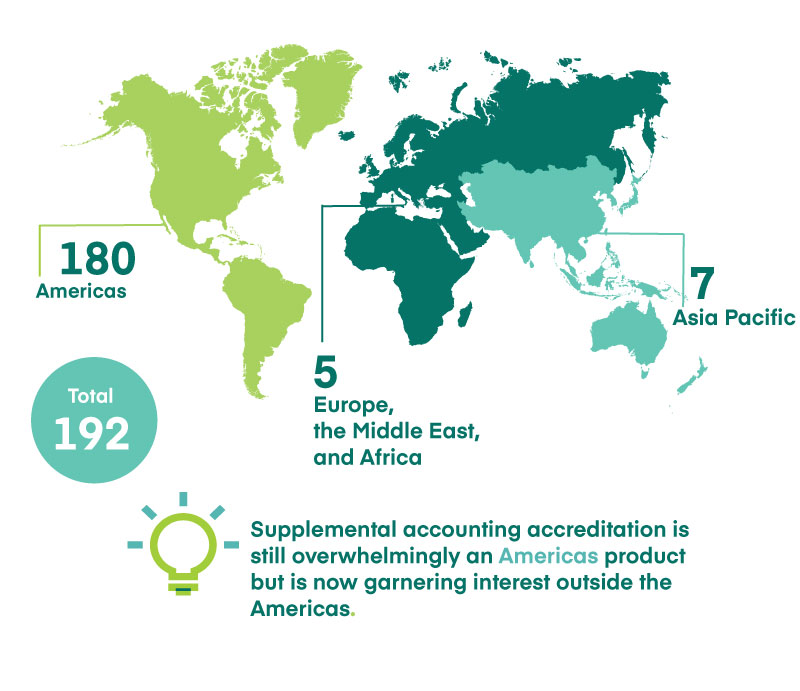
45 total visits: 6 initial and 39 CIR
Accounting Standards Mentioned for Visits Between July 1, 2021–June 30, 2022
With Extension Recommendations
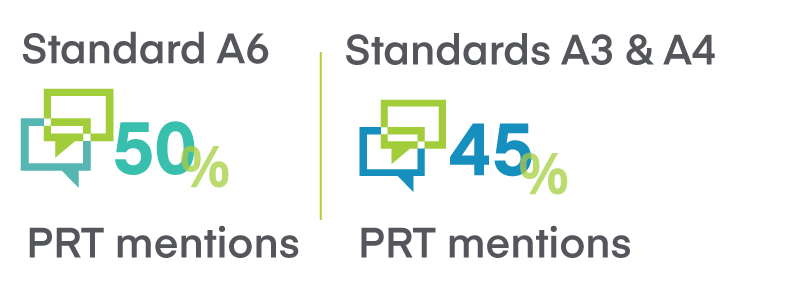
A3 Common Issues |
- In cases where research intensity and scholarly contributions expectations have increased, schools are not providing an appropriate compensation and incentive structure to attract and retain faculty who fit this profile.
- Heavy teaching loads and several preps are overwhelming faculty.
- Faculty who can teach new IT accounting courses, including analytics, must be recruited. The school cannot rely wholly on outsourcing technology-intense courses to practitioners.
- Declining accounting enrollments are negatively impacting accounting budgets.
A4 Common Issues |
- The heightened responsibility of updating accounting curriculum on a continuous improvement basis is causing some schools concern.
- The new CPA exam has a heavy emphasis on data analytics, yet schools with a strong emphasis on producing graduates who will go into public accounting are not adequately embedding data analytics into their accounting curriculum.
- AoL data is not being collected in a timely manner or in a way that informs continuous curricular improvement.
A6 Common Issues |
- Schools' stated missions to produce rigorous research are not aligned with the definitions of a Scholarly Academic.
- Faculty qualifications requirements do not match the mission of the school.
- Both tenure-track and clinical faculty are concerned about meeting increased research expectations on top of other increased responsibilities.
- Schools struggle to attract and retain qualified, diverse accounting faculty.
- A number of schools lack a healthy balance of qualified faculty, including senior faculty.
Accounting and Technology
- Accounting students need to be exposed to technology and tools beyond Excel. Technology, including data analytics, should be infused throughout the accounting curriculum. Recommended tools include: Enterprise Resource Planning (ERP) platforms, Robotic Process Automation (RPA), SAP, Microsoft Dynamics, Workiva, data visualization tools such as Microsoft Power BI, and pivot tables. Schools are encouraged to explore University Alliance partnership programs such as SAP’s certification program offered to higher ed at a nominal cost. Tax courses are also lacking exposure to software that adequately prepare graduates for the workforce.
- Not all faculty are consistently using technology to teach courses, especially when teaching the same course.
Volunteers
Thank you to our incredible volunteers!
Volunteer Training by the Numbers



To be eligible to serve on a 2020 accreditation visit, all volunteers must go through extensive training once every three years. The goals are:
- To create a renewed collegiality around the visit.
- To provide thoughtful, consultative advice from the perspective of the peer review team's extensive knowledge and experience.
- To ensure volunteers are using a principles-based mindset that focuses on whether a school is aligned with the spirit and intent of the standard and demonstrates continuous improvement.
Training includes a capstone live simulation of a peer review visit. Volunteer training is not available on demand. Instead, volunteers are assigned to training by AACSB once they have been appointed to a specific peer review team. Once completed, the volunteer is eligible to serve for three years on peer review teams, as long as the individual remains affiliated with an AACSB-accredited school.

Best Practices and Innovations
Top Areas for Best Practices Mentioned by Peer Review Teams

Topical Best Practices
Partnerships and Engagement
- One school's self-funded internship program funds internships that would otherwise be unpaid.
- A school with a particular emphasis on entrepreneurship and startups provides consulting and mentoring to startup companies, taking equity stakes that convert intellectual property into equity assets.
- New certificates proliferate, including:
- Professional Sales
- Financial Literacy
- Project Management
- Entrepreneurship
Research Programs
- A number of schools offer internally funded research chairs.
- In many cases, schools offer rewards for publication to spur productivity.
- Strong leadership and a culture of collegiality, transparency, and inclusivity are frequently mentioned in school visit reports as keys to successfully motivating and encouraging faculty research.
Advisory Boards/Councils
- Schools with alumni and student advisory boards are able to get ample stakeholder input.
- Business school advisory boards are often integral to providing school leaders with feedback and consultation on curriculum and strategy and helping them ensure a current and relevant curriculum..
Diversity, Equity, Inclusion, and Belonging School Examples
The University of Otago
Working With Indigenous Peoples
This school stands out in the area of societal impact. Its mission and strategy emphasize Māori and Pacific peoples and businesses, which threads through all key activities of the school, including curriculum, scholarship, and engagement.
One notable outcome is the Te Maea network. With awarded funding from the university, Te Maea builds capacity to do research that contributes to Māori and Indigenous enterprises. Māori students across all levels are invited to take part in research or business advisory projects.
Colorado State University
Inclusive Practices
This school's peer review team commended its work to make diversity, equity, inclusion, and belonging a central responsibility for faculty, staff, and students. The school demonstrated clear efforts toward building a strong, inclusive culture that resulted in widespread organizational changes. Particularly noteworthy are the school's focus on continuous improvement through experimentation, learning from both success and failure, and the creation of an inclusive and open culture that values each individual community member.
North Carolina A&T
Partnerships That Advance Diversity
This school partnered with the North Carolina Association of Certified Public Accountants to launch a series of continuing professional education courses led by underrepresented minority faculty to make an impact in this area.
Consultative Advice
Mission Alignment
- Schools received great consultative advice around mission alignment and assurance of learning.
- Noted by one peer review team: “The school can be ambitious enough to derive the budget from the ambition and not the ambition from the budget."
- Peer review teams expect schools to align internationalization in their missions and strategic plans with the schools' outcomes.
Assurance of Learning
- Schools do not need to measure every competency goal every year.
- One peer review team noted that a school's AoL system was "exceptionally comprehensive," but it would benefit from simplification to enable deeper reviews and more impactful innovation. The team suggested that the school could collect annual data at higher level, just looking for red flags, and alternate more comprehensive program reviews every couple of years.
Societal Impact
Societal Impact Expectations Under the 2020 Standards
An accredited school is expected to select one or more focus areas to embed in its strategic plan related to how it plans to make a positive impact on society. The school should strive to infuse that/ these chosen area(s) of focus into its curriculum (Standard 4), scholarship (Standard 8), and external engagement and partnership activities (Standard 9).
Though the 2021–22 academic year is the first robust application of the 2020 standards, we see early trends in the focus areas schools are choosing.
Schools can opt to use any framework they wish for reporting their focus area of societal impact. The U.N. Sustainable Development Goals (SDGs) are suggested in the Interpretive Guidance to the standards.
As expected with new standards, schools are quite immature in their societal impact plans. Most schools are just figuring out the areas in which they want to concentrate their efforts.
Schools need to progress beyond a list of service activities. Activities should be strategically connected to the chosen focus area. The texts introducing the Sustainable Development Goals were taken from the United Nations website.
Source: AACSB Societal Impact Survey 2021 (n=74).
Areas of Impact
 |
Quality Education
A key theme in this area highlighted by numerous schools visited last year is the important work they are doing to promote financial literacy, within both their schools and their communities. Schools are intentionally integrating financial literacy into their curricula, as well as engaging in active outreach within their local high school communities. Another area that emerged related to quality education is support of learners with special needs, including programs that improve access and inclusiveness among this population.
|
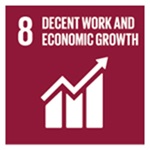 |
Decent Work and Economic Growth
Many schools have centers that provide great value to their communities, such as small business development, entrepreneurship, or innovation centers. The job creation supported by these centers serves as a key outcome for schools in regard to this SDG. Experiential learning activities also yield exceptional outcomes in this area. Business students are contributing thousands of hours of free consulting, often to companies that could not otherwise afford such services. Another noteworthy outcome in this space relates to one school’s example of conducting rural entrepreneurship workshops in its state, including collaboration with Indigenous communities in its region.
|
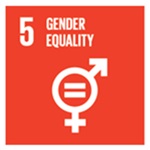 |
Gender Equality
There was no shortage of impressive work among AACSB schools in the area of gender equality. Multiple schools reported offering female learners tuition waivers, particularly at the graduate level. Other schools reported differential fees for women participating in executive education programs in order to improve access to these programs among women. Gender is an area in which numerous schools are engaged in substantial scholarship, with many impactful journal articles produced by AACSB schools visited in the last year alone. And one school has set up a unit specifically for victims and witnesses of gender-based crimes, offering much needed support to an often underserved population.
|
Societal Impact School Examples
Sheffield University Management School
Centre for Decent Work (CDW)
A commitment to positive societal impact, with a focus on socially responsible management practices, is at the heart of the school’s identity and has permeated every core activity. A notable exemplar of its impactful research is The Centre for Decent Work (CDW), focused on examining contemporary issues and developments relating to decent work, workplaces, and labour markets. CDW ensures the benefits of research are delivered to workers, employers, policy bodies and practitioner organizations around the world through close engagement with a range of organizations, such as the International Labour Organisation (ILO), and its network of international academic collaborators.
IE Business School
LGBT+@Work
LGBT+@Work is truly a result of student-led activism that has been passed forward from one generation of LGBT+ students at IE Business School to the next—each time with the new cohort adding more to the movement and building on the foundation they inherited. In 2017, LGBT+@Work grew to become the third-largest LGBT+ conference of its type in the world. The conference and support from the IE Foundation helped foster partnerships with organizations like REDI, the first inter-business diversity and inclusion (D&I) network in Spain. This continued success was built upon, creating an international spin-off in New York City, providing training for ERGs, and supporting local community projects, such as Fundación Eddy-G, which provides shelter to victims of LGBT-phobia. After 13 years of continuous growth, the conference faced its biggest challenge: the pandemic. Determined not to cancel the event, the students took the conference online. No one could have predicted the conference exploding to a truly global reach with more than 2,000 participants tuning in from all over the world.
Thompson Rivers University, Bob Gaglardi School of Business and Economics
Splatsin-TRU Business Development Project
The school strives to increase collaboration with Indigenous communities and the businesses within to develop educational programs that respond to regional needs. The Splatsin—pronounced “splat-seen”—Nation is one of 17 remaining bands out of an original 32 that make up the Secwépemc—pronounced “she-whep-m”—Nation. Splatsin applied for and received a Community Workforce Response Grant (CWRG). The CWRG funds relevant skills training with the end goal of secure and sustainable employment for unemployed or precariously employed British Columbians. Splatsin requested the school’s support to ensure the training was regionally relevant, and the school strived to work respectfully and collaboratively with the Splatsin Nation to develop programming that was culturally relevant and appropriate. The Splatsin First Nation-TRU Business Development Project provided an opportunity for the school to support the inclusion of Indigenous people in both education and economic environments.
Looking Forward
For schools with 2022–23 visits, there are three prominent areas of focus that schools should be mindful of:

The Continuing COVID-19 Pandemic and Visit Modality
Plan for a face-to-face visit; keep hybrid and virtual options open if needed. Be agile.
While the pandemic appears to be abating, COVID-19 has not disappeared. Further the recovery is uneven geographically, with a striking gap between countries in low and high levels of development.
The pandemic will be a multiyear recovery.
Multiple sources estimate that almost one-third of the world has not yet received access to vaccines. And, new strains of COVID continue to hinder efforts toward a full return to normal operations for universities and business schools.
The pandemic thus continues to impact how accreditation visits are conducted. As we now enter our third academic year of dealing with the pandemic, we are seeing a movement toward more face-to-face visits. Because none of us has a crystal ball, our overarching goal is to plan, but remain agile.
With this goal in mind, schools should plan for a face-to-face visit. If doing so becomes unfeasible either due to conditions at the host school or on the volunteer side, consult with AACSB for options related to a hybrid or a virtual visit.
Delivery of Instruction: The Criticality of Engagement
No matter what the modality, or what the size of class, the primary instructor should have regular, meaningful contact with learners, and the degree should involve adequate learner-to-learner engagement in activities.
AACSB accreditation standards have long held engagement, impact, and innovation as critical components of a quality education. Nowhere is this triad more important than in the delivery of our educational programs. Innovative technology and pedagogy is encouraged and welcomed.
This includes faculty-to-learner engagement and learner-to-learner, or peer engagement. The caution here is with respect to modalities of instruction that do not reflect and uphold the expectations of engagement.
What’s Key
Instructional delivery methods vary widely around the world. Large lectures coupled with tutor-led small groups can be an effective delivery method. Online degree programs partnering with an educational technology company can be high quality. Conversely, a small class where the instructor has no regular and meaningful contact with the learners is not meeting the spirit and intent of the accreditation standards.
Developing a Societal Impact Plan
Focusing on societal impact is not about more service. Rather, it is about your school using its business expertise in a chosen focus area to help solve societal problems, whether they are at the local community level, regional, national, or international.
The 2020 Guiding Principles and Standards for Business Accreditation renew and elevate the importance of business education as a force for good in society. To this end, four of the nine 2020 accreditation standards contain an emphasis on societal impact. Essentially, each school should identify one or more areas of focus for accreditation purposes that relate to its societal impact.
That focus area should be identified in the school’s strategic plan (Standard 1) and then should be woven through the school’s curriculum (Standard 4), its scholarship (Standard 8), and its engagement activities with internal and external parties (Standard 9).
Expect peer review teams to ask about your chosen focus area(s) for societal impact and how you plan to measure success.
Create a microplan for how your school will make a positive impact in society. Make sure to embed it in your strategic plan. Have goals and measures of success that you evaluate at least annually, and keep a record of your achievements over time. Table 9-1 in the accreditation standards is the best way to record your annual activity and report for accreditation purposes. Expect this to be a long-term effort over many years. Transformational impact takes years to occur. The goal is to make progress over time.
The question of how to measure societal impact is a popular topic. However there is no one set of standardized metrics that can be globally applied. Success depends greatly on context. Your school decides what you want to focus on, and you set goals and measures of success accordingly. AACSB is about continuous progress.
Societal impact metrics for success are context-specific. You are empowered to create a vision and decide how you will measure success.






